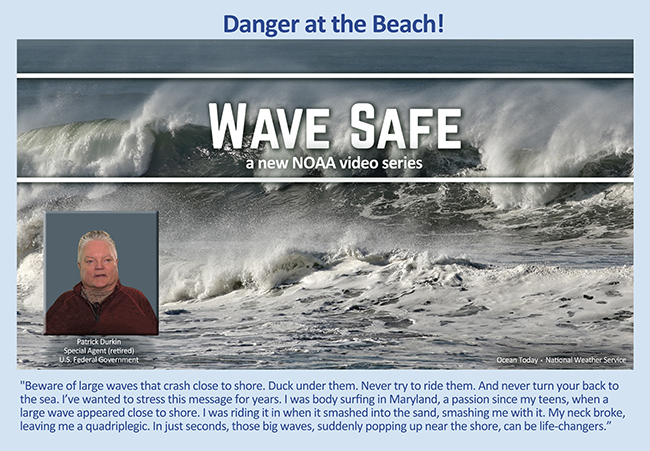
A trip to the beach should be fun. Unfortunately, many people are injured or killed along our nation's beaches by hazards sneaker waves and log rolls. The National Weather Service can help ensure you leave the beach with good memories. NWS provide you the information you need to stay safe on beaches and in coastal areas and surf zones. A surf zone is defined as the area of water between the beach/shore and the first line of breaking waves. See our photos of dangerous waves.
Individuals planning to visit the beaches of North California, Oregon, and Washington State should educate themselves about the naturally occurring hazards at these beaches. Study wave patterns, never stop watching and listening to the ocean. It can change suddenly. Sneaker waves can surge high up the beach without warning catching the inattentive individual off guard. Expect these waves to move with great speed farther up the beach than you think is safe. No place on the beach is too high for the wave to reach. Be aware of the following dangers:
Exposure to the cold water can cause cold water paralysis to set in in the limbs within minutes further impairing the individual’s ability to escape the wave. It's important to always have an escape route when you're on the beach, especially the steep, enclosed beaches of the Northwest.
The coastline of Northern California, Oregon and Washington State are steep, tree lined, and have cold to frigid water temperatures. These beaches are quite unlike the flat, broad beaches of Southern California with their inviting warm water temperatures. The steep slopes of the Northwest’s coastlines are much more likely to cause sneaker waves; the trees that line the cliffs can wind up in the swift ocean currents running along the shoreline; while the cold to frigid temperatures, depending on the season, can induce cold water paralysis for anyone caught in these northwestern ocean waters.
While in Southern California people at the beach are in bathing suits or light summer clothes wading and swimming in warm waters with open beaches, in contrast in the North they wear heavier clothes, coats, shoes, and boots due to the cooler temperatures and in autumn and winter those waters are frigid. Encounters with the waves in Southern California, with its warm water temperatures and broad beaches, might simply knock a person over on the beach, but in the North the cold water temperatures could induce cold water paralysis rendering the individual helpless to escape the pull of the receding wave returning to the ocean.
Always respect the ocean on the beaches of the North Coast of California, Oregon, Washington with their steep, rugged tree lined coasts, and frigid ocean temperatures.